History
The tavern originally opened in 1819 on the Richmond-Lynchburg Road for travelers and is the oldest original structure in the village of Appomattox Court House, with the exception of the Sweeney Prizery outside of the local of the village but within the Park. [4] The Clover Hill Tavern inn grew and farmhouses grew up around it soon after it opened. It was built by Alexander Patteson and his brother Lilburne Patteson as a stagecoach stop for the line between Cumberland County and Lynchburg. [3]
In 1865, on Palm Sunday, the rapidly approaching end of the Civil War changed the prosperity of the Clover Hill Tavern with the surrender of General Robert E. Lee to General Ulysses S. Grant. The Generals arranged a meeting to be held in town at the McLean House so Lee could formally surrender his troops to Grant, effectively ending the American Civil War. Approximately thirty thousand paroles for the Confederate soldiers were printed in the Clover Hill Tavern. [5]
At the time of General Lee's surrender to Union commander Grant in 1865 the Tavern and its associated outbuildings were owned by Wilson Hix. Billy Hix, Wilson's son, was the sheriff of the village of Appomattox Court House then. Brigadier General George H. Sharpe, as head of the Bureau of Military Information and Assistant Provost Marshal, made the Clover Hill Tavern his headquarters starting on April 10, 1865. Sharpe was designated by Grant to oversee the printing of parole passes which were issued to the Confederate veterans. Research by historians of the Park reveal that perhaps the paroles were printed in the wooden dining room wing at the west end of the Tavern that no longer is there. [4] The paroles allowed the surrendered Confederate soldiers to travel unmolested to their homes. [5]
A National Park Service marker at the front entrance of the Clover Hill Tavern reads: [6]
Built in 1819, this was the first building in what would become the village of Appomattox Court House. The Clover Hill Tavern served travelers along the Richmond-Lynchburg Stage Road. For several decades, it offered the village’s only restaurant, only overnight lodging, and only bar. Its presence helped prompt the Virginia legislature to locate the Appomattox County seat here. In 1846, the courthouse was built across the street.
By 1865, the tavern had come on hard times – a "bare and cheerless place", according to one Union general. It was one of only two buildings in town used by the Federal army during the surrender process. Here, on the evening of April 10, 1865, Union soldiers set up printing presses and started producing paroles for the surrendered Confederates. The Federals printed more than 30,000 parole documents here.
Physical description
The Clover Hill Tavern is constructed of local brick laid in a Flemish bond. The two-story structure has a full attic. It is thirty-nine feet (12 m) wide by twenty-three feet (7.0 m) deep. The south facade is four-bays with a full-length porch. Brick foundation piers support the porch. [7]
The wood shingle roofs cover both the porch and building. The wood shingle roof on the main building is supported by a corbelled brick cornice. The gable ends have rakes with dentils. The east and west gable ends have external, centered, brick chimneys. The wood paneled doors have fan lights above are found on the south and west sides. There is original stenciling and painting exposed on the plaster in the western room stair enclosure. [4] There is evidence of graining on all the interior trim. [3]
The Clover Hill Tavern structure has four bays on each floor. It has a full length porch on the first floor which is supported on brick foundation piers. The windows are non-operable louvered with two panels. The west side has an entrance with the south side being the main entrance. The rear of the building is identical to the front, except in reverse. The building has a full attic and no cellar. The Clover Hill Tavern was restored in 1954 by the Park. [3]

Appomattox is a town in Appomattox County, Virginia, United States. The population was 1,733 at the 2010 census. It is the county seat of Appomattox County.

Wilmer McLean was an American wholesale grocer from Virginia. His house, near Manassas, Virginia, was involved in the First Battle of Bull Run in 1861. After the battle, he moved to Appomattox, Virginia, to escape the war, thinking that it would be safe. Instead, in 1865, General Robert E. Lee surrendered to Ulysses S. Grant in McLean's house in Appomattox. His houses were, therefore, involved in one of the first and one of the last encounters of the American Civil War.

The Appomattox Court House National Historical Park is a preserved 19th-century village in Appomattox County, Virginia. The village is the site of the Battle of Appomattox Court House, and contains the McLean House, where the surrender of the Army of Northern Virginia under Robert E. Lee to Union commander Ulysses S. Grant took place on April 9, 1865, an event widely symbolic of the end of the American Civil War. The village itself began as the community of Clover Hill, which was made the county seat of Appomattox County in the 1840s. The village of Appomattox Court House entered a stage of decline after it was bypassed by a railroad in 1854. In 1930, the United States War Department was authorized to erect a monument at the site, and in 1933 the War Department's holdings there was transferred to the National Park Service. The site was greatly enlarged in 1935, and a restoration of the McLean House was planned but was delayed by World War II. In 1949, the restored McLean House was reopened to the public. Several restored buildings, as well as a number of original 19th-century structures.

The Battle of Appomattox Court House, fought in Appomattox County, Virginia, on the morning of April 9, 1865, was one of the last battles of the American Civil War (1861–1865). It was the final engagement of Confederate General in Chief, Robert E. Lee, and his Army of Northern Virginia before they surrendered to the Union Army of the Potomac under the Commanding General of the United States Army, Ulysses S. Grant.
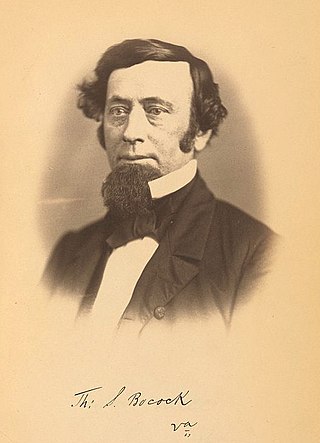
Thomas Salem Bocock was a Confederate politician and lawyer from Virginia. After serving as an antebellum United States Congressman, he was the speaker of the Confederate States House of Representatives during most of the American Civil War.
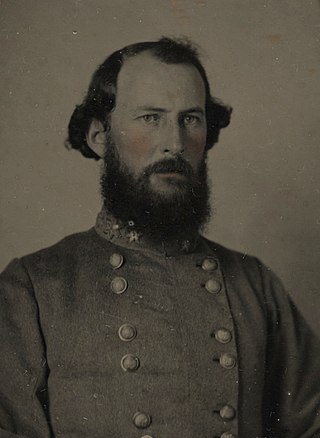
Bryan Grimes was a North Carolina planter and a general officer in the Confederate Army during the American Civil War. He fought in nearly all of the major battles of the Eastern Theater of that war.

Altona, near Charles Town, West Virginia, is a historic farm with an extensive set of subsidiary buildings. The original Federal style plantation house was built in 1793 by Revolutionary War officer Abraham Davenport on land purchased from Charles Washington. The house was expanded by Abraham's son, Colonel Braxton Davenport. During the Civil War the farm was a favored encampment. Generals Philip Sheridan and Ulysses S. Grant both used the house as a headquarters and meeting place.

The Allstadt House and Ordinary was built about 1790 on land owned by the Lee family near Harpers Ferry, West Virginia, including Phillip Ludwell Lee, Richard Bland Lee and Henry Lee III. The house at the crossroads was sold to the Jacob Allstadt family of Berks County, Pennsylvania in 1811. Allstadt operated an ordinary in the house, and a tollgate on the Harpers Ferry-Charles Town Turnpike, while he resided farther down the road in a stone house. The house was enlarged by the Allstadts c. 1830. The house remained in the family until the death of John Thomas Allstadt in 1923, the last survivor of John Brown's Raid.

The McLean House near Appomattox, Virginia is within the Appomattox Court House National Historical Park. The house was owned by Wilmer McLean and his wife Virginia near the end of the American Civil War. It served as the location of the surrender conference for the Confederate army of General Robert E. Lee on April 9, 1865, after a nearby battle.

The Old Appomattox Court House is a former county courthouse within the Appomattox Court House National Historical Park. In the 1800s this structure gave the surrounding village the name Appomattox Court House. Built in 1846, the structure served as the courthouse for Appomattox County, Virginia. Confederate General Robert E. Lee surrendered his army nearby in 1865, during the closing stages of the American Civil War, but the courthouse was closed that day and was not used in the proceedings. The village where the old courthouse was located had entered a state of decline in the 1850s after being bypassed by a railroad, and when the courthouse burned down in 1892, the county government was moved to Appomattox, Virginia.

The Charles Sweeney Cabin is a structure within the Appomattox Court House National Historical Park. It was registered in the National Park Service's database of Official Structures on June 26, 1989.
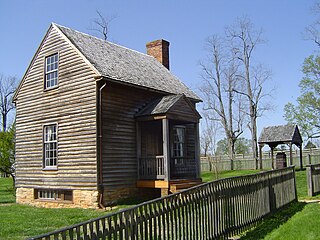
The Jones Law Office, also known as the Lorenzo D. Kelly House, is a structure within the Appomattox Court House National Historical Park. In the nineteenth century the structure was owned by Kelly and used as a single-family house. The original law office was also used as a dwelling by John Robinson for his large family in the nineteenth century after Kelly.

The New County Jail is a structure within the Appomattox Court House National Historical Park. It was registered in the National Park Service's database of Official Structures on June 26, 1989.
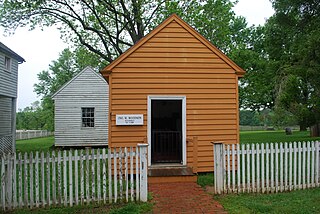
The Woodson Law Office is a structure within the Appomattox Court House National Historical Park. It was originally built by Samuel McDearmon in 1854 and rented by Woodson for his law office until he purchased it a couple of years later. It is a small structure and was built next to the main general store of Appomattox.

The Peers House is a structure within the Appomattox Court House National Historical Park. It was registered in the National Park Service's database of Official Structures on June 26, 1989.

The Bocock–Isbell House is a structure within the Appomattox Court House National Historical Park. It was registered in the National Park Service's database of Official Structures on June 26, 1989.
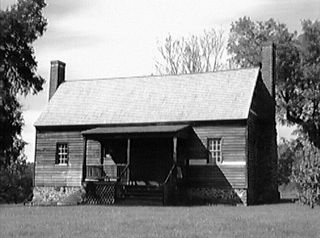
The Mariah Wright house is a structure within the Appomattox Court House National Historical Park. It was registered in the National Park Service's database of Official Structures on June 26, 1989.

The Sweeney Prizery is a structure within the Appomattox Court House National Historical Park. It was registered in the National Park Service's database of Official Structures on June 26, 1989.

Sycamore Dale is a 19th-century Greek Revival plantation house overlooking the South Branch Potomac River southwest of Romney, West Virginia. Sycamore Dale is one of several historic estates along South Branch River Road. It was listed on the National Register of Historic Places on December 2, 1980.
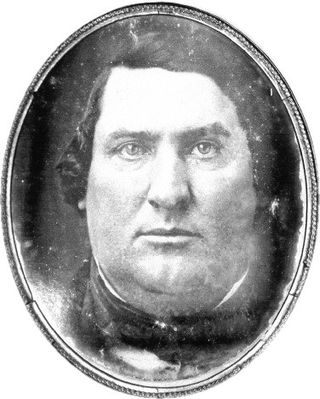
Samuel Daniel McDearmon (1815–1871), also known as Samuel D. McDearmon, was a Confederate army officer during the American Civil War. He held a number of political and government offices, and played a significant role in the development of Appomattox and Appomattox Court House, Virginia.



























